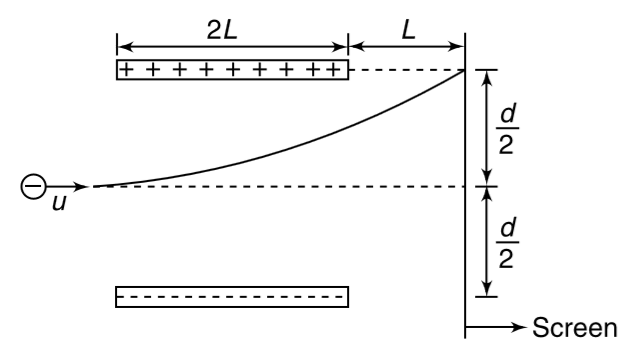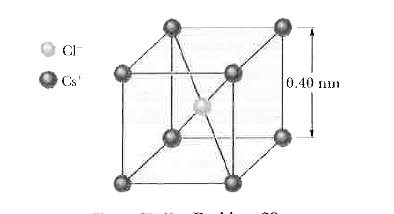Na Cl moecule is bound due to the electreic force between the sodium and the chlorine ions when one electron of sodium and the chlorine ions when one electron of sodium is transferred to chlorine. Taking the separaton between the ions to be find the force of attraction between them. State the assumptions (if any) that you have made.
Topper's Solved these Questions
- ELECTRIC FIELD AND POTENTIALBOOK - HC VERMACHAPTER - ELECTRIC FIELD AND POTENTIALEXERCISE - Objective 2
8 Videos
- ELECTRIC CURRENT THROUGH GASESBOOK - HC VERMACHAPTER - ELECTRIC CURRENT THROUGH GASESEXERCISE - Exercises
23 Videos
- ELECTROMAGNETIC INDUCTIONBOOK - HC VERMACHAPTER - ELECTROMAGNETIC INDUCTIONEXERCISE - EXERCISE
9 Videos
Similar Questions
An electron (charge = e, mass = m) is projected horizontally into a uniform electric field produced between two oppositely charged parallel plates, as shown in figure. The charge density on both plates is ± σC/m2 and separation between them is d. You have to assume that only electric force acts on the electron and there is no field outside the plates. Initial velocity of the electron is u, parallel to the plates along the line bisecting the gap between the plates. Length of plates is 2L and there is a screen perpendicular to them at a distance L. (i) Find s if the electron hits the screen at a point that is at same height as the upper plate.
(ii) Final the angle q that the velocity of the electron makes with the screen while it strikes it.

View SolutionA potential difference of 20 volts develops between the plates of the capacitor when 2×1012 electrons are transferred from one plate of the capacitor to the other. What should be the capacitance of capacitor?
View Solution
Knowledge Check
A force F acts between sodium and chlorine ions of salt (sodium chloride) when put 1 cm apart in air. The permittivity of air and dielectric constant of water are ε0 and k respectively. When a piece of salt is put in water, electrical force acting between sodium and chlorine ions 1cm apart is
AFkBFkε0CFkε0DFε0kThe electrostatic force of repulsion between two positively charged ions carrying equal charge is 3.7×10−9N, when they are separated by a distance of 5Å. How much electrons are missing from each ion?
A10B8C2D1A cylindrical copper conductor AB length L areaa of cross-section a has large number of free electrons which at mean temperature move at random within the body of the conductor like the molecules of a gas. The average thermal motion at room temperature is of the enter of 105ms−1 where a potential difference V is applied free electronic in the condictior experience , the free electrons in the conductor experience force and are accelerated towards the positive emf of the condutor on their gained kinetic energy After each collision the free electronic are angle acceleration due of the electric field , towards the positive end the conductor and next collision with the ions/atoms of the electrons The average speed of the free electrons with which they drift toward the positive and of the conductor under the effect of applied electric field is called drift of the electrons
The motion of electrons in between two successive collisions with the atoms/ions followsAa straight pathBcircular pathCelliptical pathDcurved path
The Bohr moden does not apply when more than one electron orbit the nucleues because it does not account for the electrostatic force that the electron exert on one another.For instance , an electrically neutral lithium atom (Li) contains three electrons in orbit around a nucleus that includes three protons (Z=3), and Bohr's model can be used for the doubly charged positive ion of lithium (Li2^(+)) that results when two electrons are removed from the neutral atom, leaving only one electron to orbit the nucleus . Obtain the ionization energy that is needed to remove the remaining electron from (Li2^(+))
View SolutionIn crystals of the salt cesium, cesium ions Cs+ form the eight corners of a cube and a chlorine ion Cl− is at the cube's center Fig. The edge length of the cube is 0.40 nm. The Cs+ ions are each deficient by one electron (and thus each has a charge of -e), and the Cl− ion has one excess electron (and thus has a charge of -e). (a) What is the magnitude of the net electrostatic force exerted on the Cl− ion by the eight Cs+ ions at the corners of the cube? (b) If one of the Cs+ ions is missing, the crystal is said to have a defect, what is the magnitude of the net electrostatic force exerted on the Cl− ion by the seven remaining Cl+ ions ?

View SolutionTwo small iron particles, each of mass 280 mg, are. placed at a distance 10 cm apart. If 0.01% of the electron. of one particle are transferred to the other, find the. electric force between them. Atomic weifht of iron is 56gmol− and there are 26 electrons in each atom of iron.
View SolutionElectron Affinity of Cl is 3.7 eV. How much Energy released in kCal when 2g of gaseous chlorine atoms is converted to cl ions in the gaseous state.
View SolutionThe electrostatics force of repulsion between two positively charged ions carrying equal charge is 3.7×10−9N when these are separated by a distance of 5Å. How many electrons are missing from each ion?
View Solution
